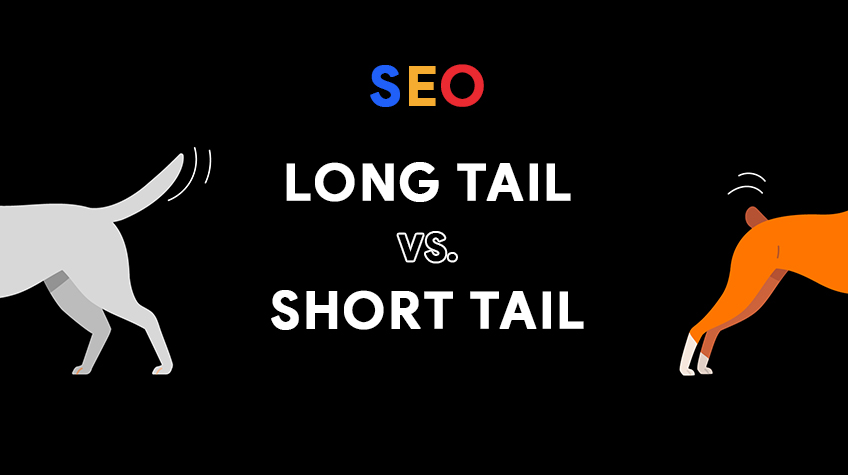
Living in the digital age is the most exciting thing to embrace. People depend heavily on the internet for everything, from everyday shopping needs to planning their trips abroad. In such a situation, it becomes indispensable for digital marketers, companies, and SEO experts to use the right long tail keywords and short tail keywords.
Yes, keywords play a crucial role when it comes to the ranking of your site. Digital marketers, SEO experts, and content creators need to be really clear about using keywords. When using keywords, make sure they are relevant and significant.
Embracing the nukes and corners of digital marketing techniques is vital for enhancing the website’s SEO rankings. Yes, today’s trendy world urges many people to switch to digital marketing over traditional marketing methods. So, business owners must be aware of advanced strategies to maximize both their reach and ROI.
Incorporating the right keywords is one of the most significant aspects of digital marketing strategies. If you want to learn more about keyword implementation, then read this article.
This article discusses the most important aspects of SEO rankings, i.e., long-tail keywords and short-tail keywords. Even though the fundamental aim of the keywords is the same, they differ in the path to achieving it. Well, keep exploring to learn about the differences, advantages, when to use them, and examples.
Understanding these things will assist you in enhancing your knowledge of SEO and make you fly high in the digital realm. Without further delay, let’s begin!
Table of Contents
- Keywords: An Introduction
- Types Of Keywords
- What Are Long Tail Keywords?
- Difference Between Long Tail Keywords And Short Tail Keywords
- When To Use Long Tail Keywords?
- When To Use Short Tail Keywords?
Keywords: An Introduction
First of all, let’s know what a keyword is and its importance before digging deeper into long-tail keywords and short-tail keywords!
Keywords are nothing but the exact search queries of users that are added to the content to optimize search engine rankings. SEO specialists effectively perform keyword searches and consider several factors before coming up with the right ones. It includes relevancy, search volume, competition, user intention, and ROI.
Not only does effective research boost a website, but it also helps in enhanced ranking. In addition, the right placement plays a crucial role in SEO ranking. Keywords should be seamlessly integrated into the content to appear naturally placed.
You need to follow specific rules while including keywords. For optimizing SEO, you must follow a certain set of rules, such as separating the primary, secondary, and additional keywords.
Also, you must add the main keyphrase in Meta descriptions, title tags, page URLs, H1 and H2 tags, headers, and first and last paragraphs. Most importantly, keywords must be placed strategically so that they appear natural in the content. Overusing keywords is a BIG NO! It affects the ranking adversely.
Before we move to the difference between long tail keywords and short tail keywords, we should understand the classifications of keywords. Keywords are classified into various types based on the user’s intention. Keep exploring to learn about the types in detail.
Types Of Keywords
As previously stated, performing effective keyword searches and placing relevant keywords are crucial for successful SEO. Adding to this, knowing about the types of keywords is very important in order to understand the user’s intention better. Each keyword type offers distinct benefits.
You can witness massive changes in SERPs after using the different types of keywords in the content. That means using the right keyword improves your reach and leads to enhanced results for your business. So, for this reason, you need to be aware of various types of keywords.
Here is the list of different types of keywords that you should be aware of:
- Short-Tail Keyword
- Long-Tail Keyword
- Geo-Targeting Keyword
- Short-Term Fresh Keyword
- Long-Term Evergreen Keyword
- Customer-Defining Keyword
- Product-Defining Keyword
- LSI (Latent Semantic Indexing) Keywords
- Intent Targeting Keywords (Informational, Commercial, and Transactional)
Emphasizing the importance of keywords is vital. Just imagine the scenario: a start-up has everything, like a well-structured website, exceptional-quality products, and affordable pricing. Affordable pricing and great products are what most customers look for. However, the start-up didn’t focus on the main thing (that is, using keywords) that can help attract customers. How will it be? For sure, it’s an utter waste of time and effort because he won’t be able to reach out to the customers he wishes to reach. This is because customers won’t ever locate his business as there are no keywords used in the content. This is exactly how your business gets affected without using the proper keywords.
Hence, it is crucial to know about the keywords and how they are used. Out of various types of keywords, long tail keywords and short tail keywords are the most important ones. And this article exclusively focuses on the two most important types of search queries and their notable differences.
So, without any further ado, let’s get started!
What Are Long Tail Keywords?
Both Long tail keywords and short tail keywords are important to uplift your website’s SEO rankings and organic traffic. First, let’s discuss the long tail keyword.
Long tail keywords are search queries that are longer than usual keywords. In simple words, long tail keywords are lengthy search queries, like a phrase. That’s the reason they are often known as key phrases. More often than not, these search queries are groups of words.
Example: “Lasik eye surgeon near me,” or “organic vegetable shop near me,” and so on.
This keyphrase resembles the exact intention of the user, and including it in your content helps to enhance websites as well as businesses. The search volume of long tail keywords is lower than that of short tail keywords because users make detailed searches when there is a need.
Long-tail keywords are more specific than short-tail keywords. So, using them appropriately in the content is A MUST. Doing so can elevate the SEO ranking and brand identity. Other than this, placing long tail keywords provides enormous advantages. Such as,
- Lower competition
- Better conversion rates
- Enhanced content visibility
- Can easily rank new or low-authority pages
- Optimized for voice search
- Personalized content
What Are Short Tail Keywords?
As the name says, short-tail keywords, also known as ‘head term,’ are small. Usually, they are general terms containing only 1 to 3 words. Examples include “Online Marketing Agency,” “Room for rent,” and so on.
Short-tail keywords often cover a broad topic and attract more visitors than long-tail keywords. These are general search queries that are easy to determine and use in the content.
To give an example, consider that a user wants to know about a newly launched mobile, so he searches for that brand. It can be anything like Apple, Samsung, or Vivo. You don’t want to enter the whole tech specification; all you need to do is search for the gadget name or mobile phone version (i.e.) Samsung S 70 or iPhone 17, etc.
And if your website has details about these products, then your website will be crawled and stay at the top of the SERPs. Short-tail keywords work effectively for most businesses. In addition, using short-tail keywords offers various advantages; just take a glance at them.
- Short tail keywords are easy to determine
- Easy to use and more specific for user requirements
- Enhance the SEO ranking and drive organic traffic
- Short tail keywords are easy to use in the content
- Short tail keywords appear naturally placed in the content
- Incorporating them is easier than incorporating long tail keywords.
Difference Between Long Tail Keywords And Short Tail Keywords
Here, you’re going to explore the difference between the two most important types of keywords: long tail and short tail keywords. Knowing these differences is a MUST. This knowledge can help you improve the search engine rankings and understand the exact requirements of the user. So, without further delay, let’s dive in.
1. Word Count And Search Terms
When comparing long-tail and short-tail keywords, it is important to prioritize word count and search terms. The reason for these two factors being highly noticeable differences in long tail and short tail keywords is because of their distinct characteristics.
⇒ Long Tail Keywords
As the name indicates, long tail keywords are longer and consist of three to five or more than this count. Search queries are more specific than usual terms, where users target specific niche demographics.
To give a real-time example, consider these keyphrases, “coffee shop near me,” “unisex beauty salon,” and “best shoes for athletes.” Here, you can easily identify that every search query has a specific intention. The phrase coffee shop near me denotes a particular location of a user, which means a user is looking for a café near them.
Thus, this is how long tail keywords vary according to different niches in today’s world.
⇒ Short Tail Keywords
Yes, you’re right! Short tail keywords are shorter in length and usually contain one to three words. These search queries are broad, generic, and precise. It means users search queries cover a broad topic in just two or three words.
Here are some examples of short tail keywords, café, beauty salon, best shoes, hair spa center, dental clinic, best shampoo, and so on. These are the most common search terms that everyone uses in their daily lives. Here, you can see, there are no specifications based on any particular niche, such as location, gender, etc.
Hence, people searching a query without defining their specific desires are short tail keywords.
2. Search Volume
Placing high-volume keywords in the content is an effective way to enhance the SEO rankings and traffic of the websites. Plus, experts consider search volume as a crucial factor in determining a successful content strategy. Let’s know the difference between long tail and short tail keywords in terms of search volume.
⇒ Long Tail Keywords
From the above section, you can easily identify that long tail keywords are particularly searched queries that users use during their needs. In that instance, you can even guess the volume of a long tail keyword, isn’t it? Yeah, obviously, the search volume of the long tail keywords is comparatively less because users tend to search only when there is a requirement.
Well, you can’t conclude that these long tail keywords are not used in the content. Lengthy keyphrases are suitable for optimizing websites for local businesses and voice search.
For instance, “internet café near me” clearly indicates that a searcher is looking for a café only near them.
⇒ Short Tail Keywords
Search volume of short tail keyword is high because they are generic and a wide range of users search for them. To give an idea, you can take the above example, café, which is a common search query that anyone would look for. This means the search is not location specific in this case. Definitely, the short tail keyword will be high in volume and placed in content to attract visitors globally.
3. Competition And Conversion Rates
Analyzing competition between specific keywords to place them in the content is one of the most successful SEO strategies. SEO experts or digital marketers must be aware of this prior to determining appropriate keywords for a post. Have you heard about it? Not yet; no issues! In this section, you’re going to explore the difference between long tail and short tail keywords based on competition in the SERPs and conversion rates.
⇒ Long Tail Keywords
Long-tail keywords are characterized by their optimization for meeting specific user requirements, resulting in lower competition. Optimizing content with long tail keywords is linked to low competition in search engine results pages (SERPs). This optimization allows search engines to crawl and index the content more efficiently. These keywords are highly beneficial for local businesses as they have the potential to attract customers who are located in close proximity to their establishments.
Using long-tail keywords can greatly enhance the visibility and overall success of your local business.
When discussing conversion rates, on using long-tail keywords, you can expect high conversion rates. In simple words, less competition leads to improved conversion rates.
⇒ Short Tail Keywords
Head terms have more competition in the SERPs as they are optimized to reach a global audience. High competition refers to search engines taking more time to crawl websites when it is optimized for short-tail keywords.
However, the conversion rate is inversely proportional to competition in the SERPs. Thus, you might witness a low conversion rate if you optimize sites only using short-tail keywords.
Hope you get some ideas about the difference between long tail and short tail keywords! Now, it’s time to know when to use these keywords with short tail and long tail keyword examples.
When To Use Long Tail Keywords?
Long-tail keywords refer to search terms that are highly specific to what users are looking for. In simpler terms, these search queries enhance SEO optimization.
To begin, organize your long-tail keywords into groups based on their popularity. Next, proceed to identify the phrases with the highest volume within each group. It is important to incorporate these terms into your page copy, internal links, and backlinks to enhance the search engine ranking of your pages.
The keyphrases vary depending on the niche. To understand this better, here are some examples
⇒ Example 1: Geo Factor
Scenario: A user moves to a new city, and he searches for a restaurant, like a “famous vegan restaurant near me.”
In this case, as a restaurant owner, consider using this long tail keyword, “vegan restaurant near me,” in your content. Including it can create a huge impact on the SERPs and help you target new customers.
⇒ Example 2: Age Or Gender
Scenario: A mom looking for a paediatrician enters a search query like “best paediatrician for 5 months old.”
Here, the user (mother) mentions it as 5 months old, which means the age factor in the long tail keyword. You need to optimize content according to these keywords so search engines crawl the website when this query is searched.
⇒ Example 3: Special Needs
Scenario: The user is planning to surprise their best friend and enters a query like “gifts for men under $50” or “home decor under $50.”
Here, you can clearly notice the user’s specific requirements, such as gifts, gender, and price. Adding such words or phrases to your content will help you target all the customers who have specific requirements. Doing so will boost your SEO ranking and help you have increased ROI.
When To Use Short Tail Keywords?
Let’s move on to the short-tail keywords! Compared to long tail, these head terms are short and not very specific. In that instance, using short-tail keywords in the content is easy. Take a look at the example to get clarity on when to use short-tail keywords.
⇒ Example 1: Enhance Globally
Scenario: Business owners want to uplift SEO rankings and brand names globally.
If you want to expand your business to the global market or target to reach global users, then using short tail keywords in your content is your best bet. For instance, you can review a trendy gadget or the latest technological invention related to your niche. This will help you attract people from around the world.
⇒ Example 2: Attract More Users
Scenario: Website owners need to enhance the user experience.
Whether you run your business traditionally or on digital platforms, engaging users is crucial for any business. Sometimes, users are seeking informative content. Moreover, creating original and unique content is A MUST for improving SEO ranking. Try to create original content and place the short tail keywords naturally to attract a larger potential audience. You can utilize tools to search for the right keywords so that implementation becomes easier.
⇒ Example 3: Generate Organic Traffic
Scenario: E-commerce site owners need to drive organic traffic
Optimize the content using the relevant short-tail keywords. However, it takes the required time but brings more organic traffic to the websites.
Also Read: Accurate Planning of Keywords Ranked for Effective Google Play Store Optimization
Capping Words
So, this is it for now! Hope this article has been informative for you. We believe you can understand the importance of long-tail keywords and short-tail keywords from this article. It is highly important that you utilize the most relevant keywords in your content in order to rank high on search engines. In addition, the quality of your content also matters!
Hence, it is crucial that you don’t compromise on the quality of the content and place the keywords naturally. Utilize these tips to elevate the SEO rankings and drive more organic traffic to the websites. Whether you’re a business owner or someone who owns a website, for sure, placing both long-tail and short-tail keywords accurately in your content can help you succeed in your endeavour.
Keywords MATTER! So, be wise when selecting and implementing keywords in your content!






